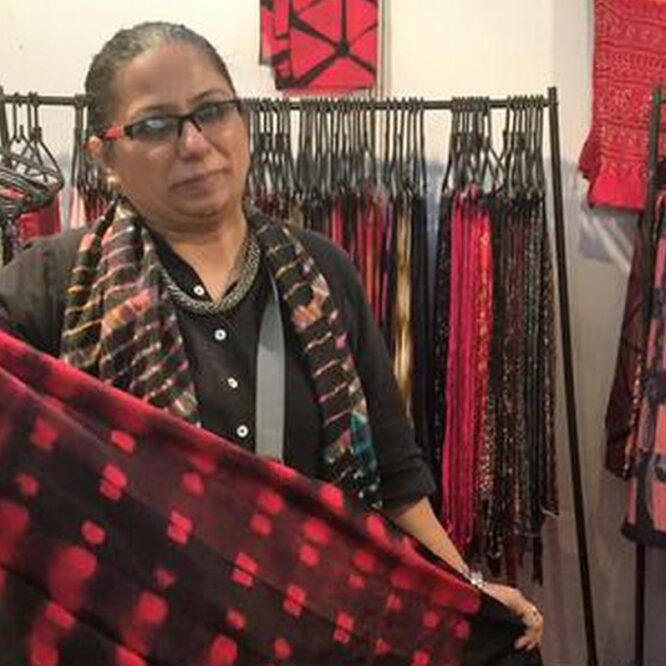Kamaldeep Kaur’s love for tie-and-dye has taken her across the world, and on her visit to Coimbatore, she talks about her journey
A conversation with Kamaldeep Kaur turned out to be an educational experience. She was in the city to participate in Crafts Council of Tamil Nadu’s Srishti where showcased her amazing array of fabrics manufactured using age-old methods of bandhni, Shibori tie-and-dye and block printing. A world-renowned expert, her detailed knowledge of these techniques were garnered through many years of exploration and experimentation.
Talking about her foray into the world of textiles, Kamaldeep said that she had always interested in patterns. When young, she drew and painted just because she enjoyed doing so. Later, when she saw a television advertisement for a fashion designing course, she realised that it could be a career option.
She joined a two-year fashion course at the South Delhi Polytechnic where she was introduced to the concept of tie-and-dye. She remembered the feeling of unbridled awe — “a magical experience” — when she made her first garment using this process. This was just one aspect of her course but it excited her the most. She then spent many hours making different combinations and patterns. By the end of the course, she had created an impressive collection of fabrics using this method and had also documented it.
This portfolio landed her a job with well-known designer JJ Vallaya, who taught her how to understand “quality, finish and colour sense”. She moved to Ahmedabad and was offered the position of designer at Gurjari (the Gujarat State Emporium) for her ‘expertise in textile techniques’. Part of her job was work with karigars for the Design Development Project. She had found her true calling.
She began to travel to the villages and meet the karigars —sometimes stayed at their homes for months — to help them hone their craft so that it would meet commercial requirements and at the same time facilitate the development of the villagers and their families. She began to search for information that would help her get as much information as possible on the craft indigenous to the people of Kutch.
Her next eye-opener came when she attended the International Shibori conference at the National Institute of Design (NID). At the subsequent conference held in Japan, she realised the impact of her work. Craft enthusiasts from around the world requested her to give talks and lecture demonstrations about her fascinating techniques. This took her to Switzerland, Malaysia, Canada, Leipzig and provided a great platform to showcase the work of India’s talented artisans. She became emotional, as she spoke of how a karigar, who had lived in penury until this project started, managed to earn enough to build a house and get his child married. A tale that he repeats to this very day whenever she visits his village.
Of course Kamaldeep had to face many challenges, apart from distance and finance. In the making of bandhini fabric, the tying is done by Muslim women of the Kathiri community who are not allowed to leave their homes. This technique is passed on from mother to daughter. The dyeing is done by the men. Then these pieces had to be transported to the office in Bhuj. Kamaldeep had to work out a system so that not only would the garments be made on time but also fit standards of quality. She also had to assure these women that they would have consistent work on a daily basis. Fifteen years ago, Kamaldeep started with eight people; today she helps provide employment to close to 600.
She has revived the process of Rogan (using minerals and oil seeds to get gold and silver prints), using metal blocks, mallots and many kinds of resist dyeing and printing. She also help the bandhini craftspersons to create their Naliya prints for the Anokhi museum. She provides a block-printing day tour in Ahmedabad that begins with how the block is made and ends with the bulk printing process
Kamaldeep said that her passion lies in textile revival, not fashion designing. She also believes that the most successful way forward is in contemporising the craft and making it suitable to today’s needs.
Just as she said that, Saindhavi Sushil, the owner and designer of the Kayal brand of clothing, turned up to buy fabric for her studio. She sources fabric from across the country and was happy to have the opportunity to buy beautiful prints for her line. This is the kind of demand that Kamaldeep envisions for her creations.
Kamaldeep has been invited by the Metropolitan Museum of Modern Art in New York to talk about her work.To know more about her work, visit www.neelgar.com Kamaldeep can be contacted at 079-26937450 or +91 9825035416. Email her atkamaldeep20@yahoo.com or Kamaldeep1974@gmail.com

